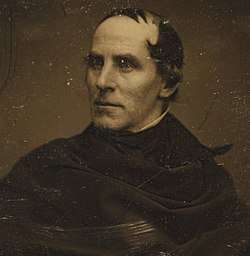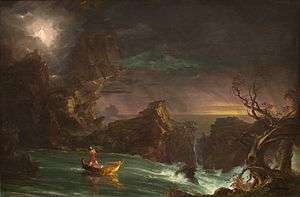The Voyage of Life
The Voyage of Life is a series of four paintings created by Thomas Cole in 1842, representing an allegory of the four stages of human life. The paintings, Childhood, Youth, Manhood, and Old Age, depict a voyager who travels in a boat on a river through the mid-19th-century American wilderness. In each painting the voyager rides the boat on the River of Life accompanied by a guardian angel. The landscape, each reflecting one of the four seasons of the year, plays a major role in conveying the story. With each installment the boat's direction of travel is reversed from the previous picture. In childhood, the infant glides from a dark cave into a rich, green landscape. As a youth, the boy takes control of the boat and aims for a shining castle in the sky. In manhood, the adult relies on prayer and religious faith to sustain him through rough waters and a threatening landscape. Finally, the man becomes old and the angel guides him to heaven across the waters of eternity.

Background
Thomas Cole is regarded as the founder of the Hudson River School, an American art movement that flourished in the mid-19th century and was concerned with the realistic and detailed portrayal of nature but with a strong influence from Romanticism.[1] This group of American landscape painters worked between about 1825 and 1870 and shared a sense of national pride as well as an interest in celebrating the unique natural beauty found in the United States. The wild, untamed nature found in America was viewed as its special character; Europe had ancient ruins, but America had the uncharted wilderness. As Cole's friend William Cullen Bryant sermonized in verse, so Cole sermonized in paint. Both men saw nature as God's work and as a refuge from the ugly materialism of cities. Cole clearly intended The Voyage of Life to be a didactic, moralizing series of paintings using the landscape as an allegory for religious faith.
Unlike Cole's first major series, The Course of Empire, which focused on the stages of civilization as a whole, The Voyage of Life series is a more personal, Christian allegory that interprets visually the journey of man through four stages of life: infancy, youth, manhood and old age. Done on commission, the finished works generated a disagreement with the owner about a public exhibition. In 1842, when Cole was in Rome, he did a second set of the series which on his return to America was shown to acclaim. The first set is at the Munson-Williams-Proctor Arts Institute in Utica, New York, and the second set is at the National Gallery of Art in Washington, D.C.
Works
Cole's renowned four-part series traces the journey of an archetypal hero along the "River of Life." Confidently assuming control of his destiny and oblivious to the dangers that await him, the voyager boldly strives to reach an aerial castle, emblematic of the daydreams of "Youth" and its aspirations for glory and fame. As the traveler approaches his goal, the ever more turbulent stream deviates from its course and relentlessly carries him toward the next picture in the series, where nature's fury, evil demons, and self-doubt will threaten his very existence. Only prayer, Cole suggests, can save the voyager from a dark and tragic fate.
From the innocence of childhood, to the flush of youthful overconfidence, through the trials and tribulations of middle age, to the hero's triumphant salvation, The Voyage of Life seems intrinsically linked to the Christian doctrine of death and resurrection. Cole's intrepid voyager also may be read as a personification of America, itself at an adolescent stage of development. The artist may have been issuing a dire warning to those caught up in the feverish quest for Manifest Destiny: that unbridled westward expansion and industrialization would have tragic consequences for both man and the land itself.[2]
Childhood
| The Voyage of Life: Childhood | |
|---|---|
.jpg) | |
| Artist | Thomas Cole |
| Year | 1842 |
| Medium | Oil on canvas |
| Dimensions | 133 cm × 198 cm (52 in × 78 in) |
| Location | National Gallery of Art |
In the first painting, Childhood, all the important story elements of the series are introduced: the voyager, the angel, the river, and the expressive landscape. An infant is safely ensconced in a boat guided by an angel. The landscape is lush; everything is calm and basking in warm sunshine, reflecting the innocence and joy of childhood. The boat glides out of a dark, craggy cave which Cole himself described as "emblematic of our earthly origin, and the mysterious Past."[3] The river is smooth and narrow, symbolizing the sheltered experience of childhood. The figurehead on the prow holds an hourglass representing time.
Youth
| The Voyage of Life: Youth | |
|---|---|
 | |
| Artist | Thomas Cole |
| Year | 1842 |
| Medium | Oil on canvas |
| Dimensions | 134 cm × 194 cm (53 in × 76 in) |
| Location | National Gallery of Art |
The second painting, Youth, shows the same rich, green landscape, but here the view widens as does the voyager's experience. Now the youth grabs the tiller firmly as the angel watches and waves from the shore, allowing him to take control. The boy's enthusiasm and energy is evident in his forward-thrusting pose and billowing clothes. In the distance, a ghostly castle hovers in the sky, a white and shimmering beacon that represents the ambitions and dreams of man.
To the youth, the calm river seems to lead straight to the castle, but at the far right of the painting one can just glimpse the river as it becomes rough, choppy, and full of rocks. Cole comments on the landscape and the youth's ambitions: "The scenery of the picture—its clear stream, its lofty trees, its towering mountains, its unbounded distance, and transparent atmosphere—figure forth the romantic beauty of youthful imaginings, when the mind elevates the Mean and Common into the Magnificent, before experience teaches what is the Real."
Manhood
| The Voyage of Life: Manhood | |
|---|---|
 | |
| Artist | Thomas Cole |
| Year | 1842 |
| Medium | Oil on canvas |
| Dimensions | 132.8 cm × 198.1 cm (52.3 in × 78.0 in) |
| Location | National Gallery of Art |
The third in the series, Manhood, shows the now-grown boy amid the tribulations of adult life. Storm clouds darken the sky. The wind whips at the man's clothing, and rain falls in the background. The river has become rocky and rapid, running through a treacherous defile marked by a gnarled, leafless tree. Gentler country lies at the bottom of the defile and the sky lightens in that direction, hinting of better times ahead. Amid the dangers, the man has not lost his faith: he has let go of his boat's tiller (which may have broken) to lift both arms in prayer. Behind him, unseen, the guardian angel continues to watch over him through a break in the clouds.
Old Age
| The Voyage of Life: Old Age | |
|---|---|
.jpg) | |
| Artist | Thomas Cole |
| Year | 1842 |
| Medium | Oil on canvas |
| Dimensions | 133.4 cm × 196.2 cm (52.5 in × 77.2 in) |
| Location | National Gallery of Art |
The final painting, Old Age, is an image of death. The man has grown old; he has survived the trials of life. The waters have calmed; the river flows into the waters of eternity. The figurehead and hourglass are missing from the battered boat; the withered old voyager has reached the end of earthly time. In the distance, an angel is descending from heaven, while the guardian angel hovers close, gesturing toward the other. The man is once again joyous with the knowledge that faith has sustained him through life. The landscape is practically gone, just a few rough rocks represent the edge of the earthly world, and dark water stretches onward. Cole describes the scene: "The chains of corporeal existence are falling away; and already the mind has glimpses of Immortal Life."
Cultural significance
The Voyage of Life was well received by critics and the public; the United States was experiencing the religious revival sometimes known as the Second Great Awakening. The four paintings were converted to engravings by James Smillie (1807–1885) after Cole's death and the engravings widely distributed in time for the Third Great Awakening, giving the series the prestige and popular acclaim it retains today.[4]
See also
- The Course of Empire, 1833–1836 series of five paintings by Cole
- Hubur
References
Citations
- Encyclopædia Britannica Retrieved December 15, 2010
- Cole, Thomas (1842), The Voyage of Life: Manhood, retrieved 2017-09-04
- Powell 1990
- Powell 1997
Cited works
- Powell, Earl A. (1990). Thomas Cole. New York: Harry N. Abrams. ISBN 0-8109-3158-3.CS1 maint: ref=harv (link)
- Miller, Angela (1993). The Empire of the Eye: Landscape Representation and American Cultural Politics, 1825–1875. Ithaca, N.Y.: Cornell University Press. ISBN 0-8014-8338-7.CS1 maint: ref=harv (link)
- Noble, Louis Legrand (1853). The Life and Works of Thomas Cole. Black Dome Press.CS1 maint: ref=harv (link)
- Powell, Earl C., III (1997). "Thomas Cole's Voyage of Life in the National Gallery of Art". Magazine Antiques (January 1997).CS1 maint: ref=harv (link)